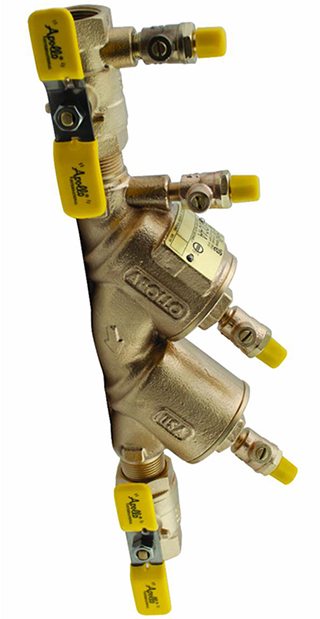What You Need to Know About Double Check Valve Assembly (DCVA)?
What is Double Check Valve Assembly (DCVA)
The double-check valve backflow preventer assembly, or DVCA, has two resilient seat check valves that act independently. These check valves are located between two shut-off valves that are closed tightly with suitable test cocks and stop valves. These are arranged in such a way that the main check valves can be tested for water tightness though Flow Water Out. DCVA is the most simple and common type of device used with two layers of backflow prevention. With no dependence on valve size, all DCVAs have 1-pound springs to close check valves during the backflow situation. 1-pound springs are used to test a backflow preventer by checking if the check valve holds a differential of 1 pound or more in backflow gauge.
How does it work?
The check valves in DCVA are designed to stand a loading capacity of holding at least 1 psi in the direction of the check valve flow where the outlet side is at atmospheric pressure. When the check valves operate normally, these open in response to outlet water demand and closes when water demand stops. When there is backpressure, the pressure increase at the outlet causes a second check valve to close tighter than the first one. When there is abacksiphonage, the pressure in the inlet is decreased to a sub-atmospheric pressure. When the pressure increases in the downstream of the second check valve, it causes it to close. In case, the second one doesn’t seal off properly, the first check valve acts as a backup to the second one.

Features of Double Check Valve Assembly (DCVA)
DCVAs are used for low hazard cross-connection applications, service protection, and internal protection in water management systems. In other words, they are basically used for isolation or containing the non-health hazard pollutants or contaminants. They can be used in case of continuous pressure, backsiphonage and also for backpressure applications. They can be installed both vertically and horizontally. They have rated backflow assemblies with shut-offs on either side of the device. These incidents include those in fire sprinkler lines, commercial pools, tanks and vats, lawn sprinklers, and food cookers. DCVAs can be installed either above ground or inline (under the ground). They cannot be used with chemigation.
How is it different than other Backflow Preventers?
The DCVA backflow assembly is designed to prevent backflow from both backpressure and backsiphonage. Some backflow preventers provide only one of them – either prevention against backpressure or backsiphonage. The major difference lies in the fact that it can be used only for low- hazard operations and have a metered bypass to detect leaks and unauthorized water use. For instance, in fire line installations, it is used to protect the potable water supply from possible pollution and contaminants from the fire system or stagnant water that sits in fire lines for longer periods of time.
Why is DCVA the best choice for Backflow Prevention?
DCVA backflow preventers are the workhorses among all the check valve assemblies. They are designed to be reliable and can handle a greater volume of flow capacities than the counterpart single valve systems. These are indispensable when there is a situation where the prevention of undesirable backflow and backsiphonage is required.
We, Smart Water Backflow, use DCVA devices that meet the requirements laid out by the American Water Works Association (AWWA) Standard for Double-Check Valve Backflow Prevention Assembly (AWWA C510-92, ASSE 1015, CSA B64.5, CSAB64.5.1) and approved by labs sanctioned by the Conference of State Sanitary Engineers.
We, Smart Water Backflow, use DCVA devices that meet the requirements laid out by the American Water Works Association (AWWA) Standard for Double-Check Valve Backflow Prevention Assembly (AWWA C510-92, ASSE 1015, CSA B64.5, CSAB64.5.1) and approved by labs sanctioned by the Conference of State Sanitary Engineers.
